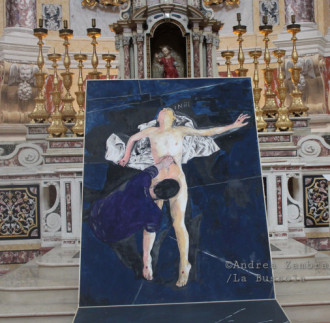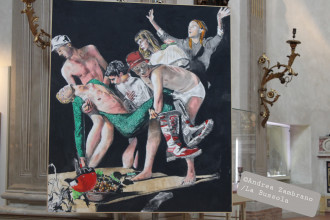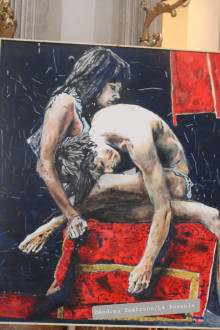Blasphemous exhibition in bishop's church. And they call it art
An exhibition by a local artist in the diocesan museum church in Carpi, is provoking indignation due to its blasphemous paintings of Jesus, Mary and Magdalene. The Daily Compass has seen the works and the exhibition guide admits they are provocative. The diocesan curators are accused of passing off sacrilege for sacred art. Bishop Castellucci is called to respond.
"But is it really what it looks like?". The visitor to the exhibition is puzzled when he sees the painting placed at the foot of the high altar of the church of Sant'Ignazio in Carpi. He can’t seem to believe his eyes. He looks at it, moves closer, scrutinises it from a different perspective. Then, brooding, between scandalised and indignant, he exclaims loudly: "But it's oral sex!".
Carpi needs more people willing to call a spade a spade, as in the fairy tale of the 'The Emperor’s New Clothes', instead of hiding behind the lapses of artistic superciliousness such as has been happening since last Saturday at the Diocese Museum. Here, in the still consecrated church of St. Ignatius, an exhibition by a local artist, a certain Andrea Saltini (pictured), was set up and inaugurated.
The exhibition is called Gratia Plena and has the ambition of defining itself as sacred art, even though there is not even a remote semblance of the sacred - visit to believe - in the paintings on display. Nor does the artist himself seem very religious, who in the interview in the catalogue, entitled Doubt as a belief system, meanders between atheism, the search for spirituality, the struggle with the divine and its attraction, in a mishmash of ideas, many and confused.
 The painting that is particularly scandalising and outraging portrays a Christ on the cross perfectly recognisable by the inscription INRI (which gives its name to the work in plaster, wax and pigmented clay) and the nail marks on his feet. Except that, there’s a man bent over Christ’s groin with his face peering closely at the Lord’s genitals (God forgive us the boldness of the words, but that is what it is) who is not even clothed in a miserable rag. His right hand is hidden behind the Redeemer's thighs, while his left hand reaches out to press Jesus' ribs.
The painting that is particularly scandalising and outraging portrays a Christ on the cross perfectly recognisable by the inscription INRI (which gives its name to the work in plaster, wax and pigmented clay) and the nail marks on his feet. Except that, there’s a man bent over Christ’s groin with his face peering closely at the Lord’s genitals (God forgive us the boldness of the words, but that is what it is) who is not even clothed in a miserable rag. His right hand is hidden behind the Redeemer's thighs, while his left hand reaches out to press Jesus' ribs.
Since this is figurative art, albeit urban in style, to anyone who looks at it, this what the the image portrays, which being applied to the figure of the Saviour evokes an instinctive revulsion in the visitor.
But how could this happen? Within minutes (the inauguration took place at 6.30 p.m. in the presence of the artist and the curators, a certain Don Carlo Bellini and Cristina Muccioli), the picture circulates in the diocese and beyond. It goes from chat to chat and even reaches the Daily Compass.
So, we went to check it out armed with a camera, convinced that there must be a rational explanation. Instead.
Instead, once inside, we were led on a tour of the exhibition, which occupies the entire sacred space of the church, which is central in plan, by a kind young guide, with the task of illustrating the works, describing their characteristics and above all revealing what the image is supposed to represent according to the artist's intentions.
.Indeed, this is the crux: Since it is contemporary art, conceptualism prevails first and foremost, so everything one sees is nothing more than a pretext to say something else, to represent what one would not even have imagined in a brain-dead and abstruse vortex where the artist's provocation is combined with the curators' deception in wanting to represent one thing, while giving it a different meaning, so that the visitor can’t understand whether to be more ignorant because he does not enter the artist's brain or more stupid because he has not realised he has been deceived.
THE 'INRI' PAINTING
So, having arrived at the INRI painting, the guide’s explanation is as follows: "It is Longinus (the centurion ed.) crushing the rib of Jesus". Now, apart from the fact that the centurion pierces Jesus' rib and does not crush it (Scripture says, "no bone shall be broken"? ), but these artistic licences are the least of the problems. The point is where the alleged Longinus puts his face: right there, in the unthinkable and outrageous groin.
We subtly point out to the guide that the sight offers something quite different from a simple rib-crushing operation. Something repulsive, something blasphemous, something profoundly sacrilegious. She smiles through clenched teeth: “Well, it could... after all, provoking is one of the artist's intentions”. So, that image, we now know, while avowedly intending to represent the centurion, could also represent, according to Saltini's provocation, that very act that we reluctantly imagine.
Obviously, this is a techniques of deception to catch out unsuspecting visitors who, having entered a church, expect anything but to be shocked: to say without saying, to dissimulate, to convey but without declaring, to let it be seen but without indicating.
 But what about the other works? Next to the INRI painting is an 'artist's homage to Caravaggio': Jesus is bleach-blond wearing a tight-fitting gay pride sparkly jumpsuit while unclothed figures hold him up. Why? It looks like a Deposition, but Saltini called the painting Ascension, evidently heedless that to be considered sacred art there must be at least an elementary knowledge of Christian iconography.
But what about the other works? Next to the INRI painting is an 'artist's homage to Caravaggio': Jesus is bleach-blond wearing a tight-fitting gay pride sparkly jumpsuit while unclothed figures hold him up. Why? It looks like a Deposition, but Saltini called the painting Ascension, evidently heedless that to be considered sacred art there must be at least an elementary knowledge of Christian iconography.
THE 'GRATIA PLENA' PAINTING
It turns out that the desire to provoke can also be found in other paintings. In Gratia Plena (photo), for example, which gives the exhibition its name, we see a triptych depicting a woman in three sequences being undressed or otherwise made the object of morbid attention by men wearing a sort of diving suit.
 The guide's explanation, prompted by the artist, is this: 'The painting depicts the Virgin being undressed by the Pharisees who want to investigate her virginal conception, but in reality she is dressing in armour'. In short, between the foolish pretence of imagining the scene and the blasphemous idea of a gynaecological inspection, the sensuality of the proposed Madonna is striking, especially in the central image where the sinuous forms of a body that is being inspected with mixed desire and invasiveness are fully evident.
The guide's explanation, prompted by the artist, is this: 'The painting depicts the Virgin being undressed by the Pharisees who want to investigate her virginal conception, but in reality she is dressing in armour'. In short, between the foolish pretence of imagining the scene and the blasphemous idea of a gynaecological inspection, the sensuality of the proposed Madonna is striking, especially in the central image where the sinuous forms of a body that is being inspected with mixed desire and invasiveness are fully evident.
Does a diocesan museum really need to host the Madonna depicted with this voyeuristic peeping Tom? Can a bishop who gives the go-ahead for an exhibition in a sacred space really tolerate doubts being cast on Our Lady's virginal conception under the pretext of the invented episode, absent in Scripture, of the Pharisaic inspection of her body?
THE "NOLI ME TANGERE" PAINTING
 That ambiguity and gaze are always oriented towards something carnal are also found in another the work that depicts a woman in her underwear, in which the nudity of her legs, arms and part of her breasts is clearly visible, who receives in her womb a lacerated and almost dying man, also naked. "The painting is called noli me tangere, which is the phrase Jesus says to Mary Magdalene (don't hold me back ed.) but the artist wanted to depict the washing of the feet". To tell the truth, the image recalls neither the iconography of the Noli me tangere, where Christ is risen, nor the washing of the feet, as is obvious. However, the message one gets from contemplating the image and the description made is that of a Christ abandoning himself in the arms of the almost lifeless Magdalene. Blasphemy? Madness? Let the reader judge.
That ambiguity and gaze are always oriented towards something carnal are also found in another the work that depicts a woman in her underwear, in which the nudity of her legs, arms and part of her breasts is clearly visible, who receives in her womb a lacerated and almost dying man, also naked. "The painting is called noli me tangere, which is the phrase Jesus says to Mary Magdalene (don't hold me back ed.) but the artist wanted to depict the washing of the feet". To tell the truth, the image recalls neither the iconography of the Noli me tangere, where Christ is risen, nor the washing of the feet, as is obvious. However, the message one gets from contemplating the image and the description made is that of a Christ abandoning himself in the arms of the almost lifeless Magdalene. Blasphemy? Madness? Let the reader judge.
What is certain is that in addition to the pure taste for provocation, an objective achieved by Saltini with these works, it is clear that the visitor is also faced with a deception proposed by the artist and espoused by the commissioners and promoters of the exhibition, namely the Diocese of Carpi.
Figurative art can be symbolic or allegorical, but it can never represent the opposite to what it declares. The deception into which visitors and even the faithful are tricked consists in the seriousness of pretending it is sacred to evoke prurient images to which a carnal and unnatural sexuality is attached, bordering - in the case of the crucifixion - on violence.
The contemporary artist's claim of forcing the viewer to enter into his own code of language that is entirely subjective, detached from any kind of minimally shared and codified symbolic rationale, is something extremely disorienting, as well as disturbing to the senses of people who are minimally endowed with some reasoning and sensitivity.
Does the Church really need to espouse operations of pictorial voyeurism capable only of profaning the sacred and disturbing the eyes and conscience? It would be interesting to ask the artist, but we have received no reply to our request.
Rupnik's works discourages worship, “it’s not sacred art”
On the debate started in Lourdes about Rupnik's works, which questions all the faithful, the Daily Compass interviewed Fr Nicola Bux: “The situation of sacred art has contributed to secularisation and the loss of faith. And Rupnik positioned himself in this void. The commissioning bishops should ask themselves whether the faithful, looking at Rupnik's art, are inspired to pray or rather to dance around the golden calf, which is ourselves”.


